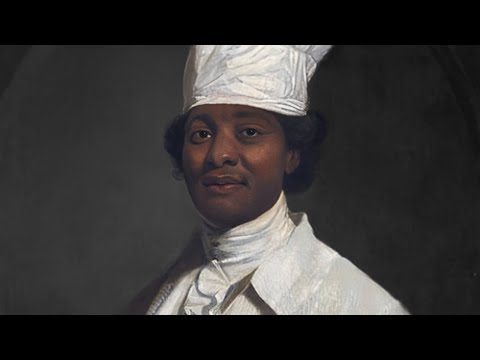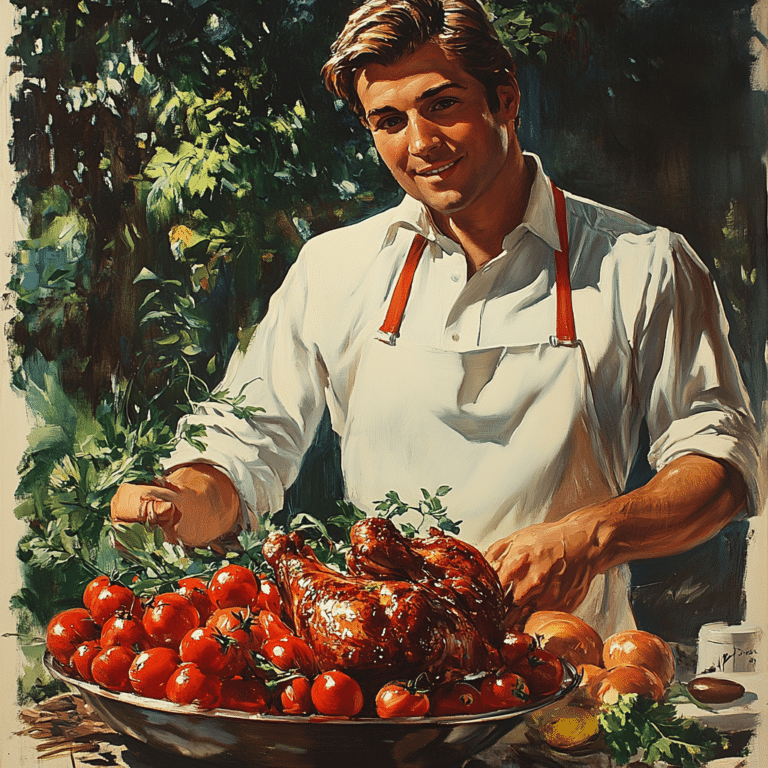Unveiling the Legacy of James Hemings: The Man Behind American Culinary Innovations
A shrouded figure in America’s gastronomic tapestry, James Hemings carries a legacy that far surpasses the recognition he’s received. His influence on American cuisine is as rich and complex as the flavors he infused into the dishes that graced colonial tables. Let’s take a scrumptious dive into the life and legacy of this culinary genius.

The Life of a Culinary Genius: Early Years to French Training
Born in 1765 at The Forest, James Hemings inherited a mosaic of cultural narratives. His father, John Wayles, a prominent slave trader and lawyer, never acknowledged his paternity to Hemings or his siblings, who had been born to Elizabeth Hemings, an enslaved woman. As destiny would have it, James would soon saunter into the annals of history not through the pages of his father’s life but through the kitchen doors of Monticello.
Under the eye of Thomas Jefferson, Hemings swiftly became an integral part of the Monticello kitchen, but hold your horses—it wasn’t just the fireplace he tended. Swept away to Paris, Hemings found himself marinating in the art of French culinary traditions. For five years, as Jefferson served as the United States minister to France, Hemings studied under French chefs, soaking up the techniques and flavors that would leave an indelible mark on American cuisine.
James Hemings and the Parisian Influence on American Cuisine
Oh, to have been a fly on the wall of those Parisian kitchens! Hemings honed skills that most American chefs could only dream of, learning to craft dishes that would later become staples in the United States. Let’s set the record straight: while James Hemings and Jefferson did not concoct macaroni and cheese from scratch, they tasted the classic noodles with cheese in France and Italy, fell culinary head over heels, and thought, “We’ve got to bring this back home!” And by golly, they did just that. Hemings’ gastronomic prowess didn’t stop there; he stirred French cooking methods into a unique blend that saw the birth of American adaptations of crème brulée and meringues.
The Complex Relationship Between James Hemings and Thomas Jefferson
You can’t exactly pin their dynamic on a kitchen fridge magnet—it was layered, to say the least. Jefferson, the man who penned the notion that all men are created equal, saw Hemings as valuable beyond measure in the Monticello kitchen. Yet, Hemings secured his freedom through a negotiation steeped in the irony of an ongoing quest for a taste of liberty that was as complex as the recipes he mastered. His manumission was contingent on passing on his culinary knowledge to another enslaved person at Monticello, a bitter garnish to his hard-won freedom.
The Enslaved Chef Who Authored American Gastronomy
In the well-seasoned halls of Monticello, James Hemings quietly laid the foundations of an American culinary revolution. He introduced Jefferson and his guests to a bevy of dishes, including his transformative take on macaroni and cheese, and chilled delights like ice cream, weaving his story into the very fabric of American culture. Yet, attributing his innovation often comes with the discomfort of acknowledging the shackles that bound him. Nonetheless, it’s vital to recognize the scope and impact of his contributions.
Rediscovering and Honoring the Mastery of James Hemings
Fast-forward to now, and Hemings is finally slicing through the dough of history with recognition. Chefs and food historians have simmered initiatives to celebrate the man who seasoned America’s palate. The recent jelly roll Cmt Awards event, as savory and musically endowed as it was, had a taste of Hemings’ historical sweetness, thanks to a nod to his contributions during the ceremonies.
The Lasting Impact of James Hemings on Modern Culinary Arts
His echoes can be traced through the spices and methodologies of modern culinary masters. As institutions shape the minds of future chefs, the mention of Hemings is no longer a mere footnote; it’s a chapter worth savoring. Renowned chefs like April Bowlby, a culinary artisan in her own right, attribute a slice of their inspirational pie to Hemings’ techniques and recipes.
Voices from the Culinary World: What Top Chefs Say About James Hemings’ Influence
Chop it up with today’s culinary moguls, and the name James Hemings will season the conversation. From liberation to libations, his legacy pours into the collective pot of American cooking and stirs a recognition long overdue. “Cooking is storytelling,” says Frédéric Arnault, a chef who views his plates as canvases for historical narratives, “and James Hemings authored chapters that we’re still reading today.”

Savoring the Historical Richness: James Hemings’ Enduring Gourmet Footprint
Let us take a moment to digest the essence of James Hemings’ story. To engage in culinary delight is to unwrap the layers of our history, acknowledging and elevating those who have flavored our nation’s narrative. It’s a table we are all invited to, set by those like Hemings, whose legacies we must continue to serve up in the dishes we treasure and the stories we recount.

| Attribute | Information |
|---|---|
| Name | James Hemings |
| Date of Birth | 1765 |
| Birthplace | The Forest, Virginia plantation |
| Parents | John Wayles (father, did not acknowledge paternity) & Elizabeth Hemings (mother, enslaved by Wayles) |
| Notable Family Member | Sally Hemings (sister) |
| Relationship with Thomas Jefferson | Enslaved by Jefferson; accompanied him to Paris as part of his domestic staff |
| Time in France | 1784-1789 |
| Culinary Training | Trained in French cuisine; considered the first American trained as a chef in France |
| Contributions to American Cuisine | Introduced macaroni and cheese, crème brulée, meringues, and snow eggs to America based on his training in France |
| Significance | Credited with bringing French cooking styles to colonial America and developing new recipes inspired by French cuisine |
| Jefferson’s Ministerial Role | United States Minister to France |
| Not invented by Hemings & Jefferson | Macaroni and cheese (they tasted it in Europe and brought it back to America) |
| Death (if applicable) | Information not provided (note: historical records show James Hemings died in 1801) |
Forging Ahead: The Contemporary Relevance of Hemings’ Culinary Innovations
With a pinch of the past and a scoop of the present, Hemings’ influence kneads into the bustling ovens of today’s food scenes and dialogues. His story, a testament to talent transcending the chains of its time, enriches our understanding of not only where we’ve been but where we are going as a culinary society.

The Gastronomic Tapestry Woven by James Hemings
James Hemings did not just cook meals; he weaved a rich gastronomic tapestry that remains vibrant in today’s culinary landscape. His narrative challenges us to view dishes not just as sustenance but as stories—a cuisine that speaks beyond the boundaries of mere flavor and into the spirit of who we are. Let’s honor this pioneer by continuing our exploration of the narratives that simmer beneath the surface of American cuisine.

So next time you bite into a helping of macaroni and cheese or savor a spoonful of crème brulée, remember the hands of James Hemings. They’re the hands that served a nation its identity, one plate at a time. Cheers to you, Mr. Hemings. Your recipes have done more than tantalize our taste buds—they’ve fed our souls.
The Culinary Artistry of James Hemings
James Hemings, a name whispering through the annals of American culinary history, was much more than just a chef—he was a revolutionary in the kitchen. His story, reminiscent of “just go with it” cast maneuvers, shows us how one man’s journey into the culinary world was filled with as much intrigue as a Hollywood plotline.
You might not believe it, but this culinary wizard was the first American to train as a chef in France, a detail as intriguing as uncovering Leaked Videos of forgotten history. Hemings honed his skill under the tutelage of some of the most prestigious chefs in Paris, resembling what Packback is to the world of academics—a meticulous cultivation of expertise and finesse. On returning to America, Hemings brought with him a treasure trove of recipes and techniques that would forever change the country’s palate.
America’s Taste Revolution
Oh, and get this—James Hemings was responsible for introducing macaroni and cheese, among other dishes, to America! Imagine attending a potluck without that creamy, cheesy comfort food. It’s as unthinkable as a seafood enthusiast in Baltimore never experiencing “jerry’s seafood.” Hemings’ influence weaved its way into the fabric of American cuisine, turning simple fare into complex flavors that would tickle the taste buds of the nation.
Did you know that Hemings wasn’t just a whiz in the kitchen? He also dabbled in the world of language. The brother of Sally Hemings, he was fluent in French, as sophisticated in linguistics as Frédéric Arnault is in the world of luxury branding. It’s rumored that amongst Hemings’ patrons was Thomas Jefferson himself, displaying a mastery of culinary skill as dazzling as Jennifer Capriatis” backhand on the tennis court. To dine on a meal prepared by James Hemings was to taste the essence of innovation—a truly mouth-watering experience.
With every dish, James Hemings threaded an invisible yarn connecting America’s culinary past to its present. Through his gastronomic creativity, he left an indelible mark on the country’s edible identity. His legacy is more than a footnote in America’s culinary playbook—it’s a full-flavored chapter of mastery and transformation.

Did James Hemings invented mac and cheese?
– Well, hold your horses! James Hemings didn’t exactly whip up mac and cheese from scratch, you see. This culinary whiz spent a good five years in Paris with Thomas Jefferson, soaking up all the French cookery he could. Sure, they didn’t invent the dish, but after getting a taste of noodles smothered in cheese in France and Italy, they couldn’t resist bringing the comfort food classic back to American shores.
Why is James Hemings important?
– Here’s the scoop on James Hemings: he’s a pretty big deal in the culinary world, especially when talking colonial America. After a stint in Paris with Jefferson, he stirred the pot by bringing those fancy French cooking techniques back home. We’re not just talking about any old recipes here; think crème brulée and meringues. Most notably, though, he’s the culinary whiz who gets a hat tip for introducing mac and cheese to America’s dinner tables.
Was James Hemings related to Sally Hemings?
– Yup, James and Sally Hemings were siblings, tied by the same family threads but living totally different lives. While James stirred the pots and played with French culinary secrets, Sally’s life was entwined with Thomas Jefferson in a more complicated way. So, yep, they were family.
Was James Hemings Thomas Jefferson’s son?
– So, here’s the twist: James Hemings wasn’t Jefferson’s son, but nephew by marriage. Hemings was born to Elizabeth Hemings, and ol’ Thomas Jefferson, well, he married Martha Wayles, whose dad, John Wayles — a man of some shady dealings — fathered James. Talk about a family tree with some tangled branches!
Which president falsely invented mac and cheese?
– No president can claim they cooked up mac and cheese all on their lonesome. Jefferson, though? He just had a presidential palate that knew what was good. After enjoying that cheesy, noodley goodness in Europe, he and James Hemings just hauled the concept back to the States, where it truly caught on. But nobody’s handing Jefferson the chef’s hat — that goes to Hemings.
Did James Hemings invent the French fry?
– Hold on, let’s not get our fries crossed. James Hemings brought over a smorgasbord of French cuisine, but the French fry isn’t on the list of dishes he’s credited with. His specialties leaned more towards the sweet and creamy side of things. So, while we can thank him for macaroni and cheese, let’s not fry our brains over who tossed the first spud into the oil.
Who inspired James Hemings to be a chef?
– James Hemings’ road to becoming a chef started when he crossed paths with Thomas Jefferson. While Jefferson was serving as the American minister in France, he took Hemings along for the ride, giving him the golden ticket to train in French cuisine. That’s where Hemings sharpened his knives — no inspiration quite like that, huh?
How old was James Hemings when he went to France?
– James Hemings wasn’t exactly a spring chicken when he sealed his passport with a French stamp; he was 19, to be precise. In the prime of his youth, he journeyed to Paris with Jefferson and marinated in all the French cuisine knowledge he could get his hands on, changing American tastes forever.
When did James Hemings become free?
– Man, when James Hemings got his freedom, it was like the best dessert after a five-course meal. It happened in 1796, after he’d been whipping up French dishes in America for a bit and negotiating with Jefferson. So, he wasn’t exactly ancient by then, but he’d certainly put in his time.
How many of Thomas Jefferson’s kids did Sally Hemings have?
– Sally Hemings and Thomas Jefferson had a complex relationship, with history books hinting at four to six kids between them. While the exact number might be up for debate, one thing’s for sure: Their ties were more than just the norm for the planned-if-you-know-what-I-mean.
How old was Sally Hemings when she got with Jefferson?
– Sally Hemings was just a teenager, about 16 or so, when she and Jefferson first got entangled, back when he was hanging around Paris as a diplomat. Times were different, sure, but that bit of their shared history still raises a whole lot of eyebrows today.
Did Sally Hemings live at the White House?
– Despite what you might think, Sally Hemings didn’t roam the hallways of the White House like some do now with a on-the-go coffee cup. Let’s remember, Jefferson’s presidential stint came after their relationship began, and there’s no record of her ever calling the presidential manor home. She stayed at Monticello, Jefferson’s Virginia estate.
Did Jefferson and Hemings love each other?
– Boy, oh boy, did Jefferson and Sally Hemings have something going on? Love or not, their relationship’s got more shades than a painter’s palette. With all the secrecy and power imbalances, pinning down “love” is like trying to nail Jell-O to a wall. Historians are still scratching their heads over this one.
Did Thomas Jefferson marry a child?
– Thomas Jefferson married Martha Wayles when she was 23, not exactly a child by 18th-century standards. Back in those days, folks tied the knot way younger than we’d imagine doing today. But no cradle-robbing here, no sir!
Who did Jefferson inherit slaves from?
– Slave-owning was a passed-down “tradition” in the Jefferson household, and he inherited his first set of slaves from his father-in-law, John Wayles. It’s a dark part of history, one that went hand in hand with all that land Wayles left behind for the Jefferson family to tend.



























